
Constans or Constans I was Roman Emperor from 337 to 350. He defeated his brother Constantine II in 340, but anger in the army over his personal life (homosexuality) and favouritism towards his barbarian bodyguards led the general Magnentius to rebel, resulting in the assassination of Constans in 350.
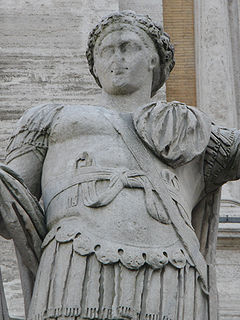
Constantine II was Roman Emperor from 337 to 340. Son of Constantine the Great and co-emperor alongside his brothers, his attempt to exert his perceived rights of primogeniture led to his death in a failed invasion of Italy in 340.

Constantine the Great, also known as Constantine I, was a Roman Emperor who ruled between AD 306 and 337. Born in Naissus, in Dacia Ripensis, the city now known as Niš, he was the son of Flavius Valerius Constantius, a Roman Army officer of Illyrian origins. His mother, Helena, was Greek. His father became Caesar, the deputy emperor in the west, in AD 293. Constantine was sent east, where he rose through the ranks to become a military tribune under Emperors Diocletian and Galerius. In 305, Constantius was raised to the rank of Augustus, senior western emperor, and Constantine was recalled west to campaign under his father in Britannia (Britain). Constantine was acclaimed as emperor by the army at Eboracum after his father's death in AD 306. He emerged victorious in the civil wars against Emperors Maxentius and Licinius to become sole ruler of the eastern and western empires by AD 324.

Sylvester I was the bishop of Rome from 314 until his death. He is regarded as the 33rd Pope of the Catholic Church. He filled the see of Rome at an important era in the history of the Western Church, yet very little is known of him. The accounts of his pontificate preserved in the seventh- or eighth-century Liber Pontificalis contain little more than a record of the gifts said to have been conferred on the church by Constantine I, although it does say that he was the son of a Roman named Rufinus. His feast is celebrated as Saint Sylvester's Day in Western Christianity on December 31, while Eastern Christianity commemorates it on January 2.
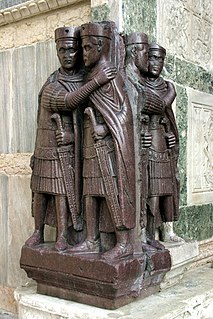
The Tetrarchy is the term adopted to describe the system of government of the ancient Roman Empire instituted by Roman Emperor Diocletian in 293, marking the end of the Crisis of the Third Century and the recovery of the Roman Empire. This tetrarchy lasted until c. 313, when mutually destructive civil wars eliminated most of the claimants to power, leaving Constantine in control of the western half of the empire, and Licinius in control of the eastern half.
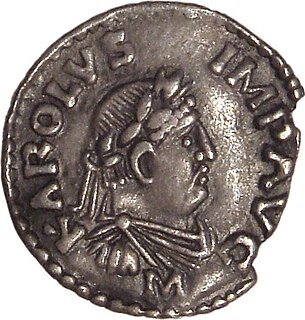
The Holy Roman Emperor, officially the Emperor of the Romans, and also the German-Roman Emperor, was the ruler of the Holy Roman Empire. The Empire was considered by the Roman Catholic Church to be the only legal successor of the Roman Empire during the Middle Ages and the early modern period. The title was held in conjunction with the title of King of Italy from the 8th to the 16th century, and, almost without interruption, with the title of King of Germany throughout the 12th to 18th centuries.

Constantine XI Dragases Palaiologos, Latinized as Palaeologus was the last reigning Byzantine emperor, ruling as a member of the Palaiologos dynasty from 1449 to his death in battle at the fall of Constantinople in 1453.

Constantius I, posthumously known after the sixth century as Constantius Chlorus, was a Roman Emperor. He ruled as Caesar from 293 to 305 and as Augustus from 305 to 306. He was the junior colleague of the Augustus Maximian under the Tetrarchy and succeeded him as senior co-emperor of the western part of the empire. Constantius ruled the West while Galerius was Augustus in the East. He was the father of Constantine the Great and founder of the Constantinian dynasty.
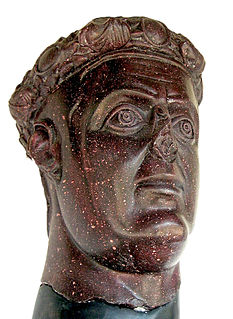
Galerius was Roman emperor from 305 to 311. During his reign, he campaigned, aided by Diocletian, against the Sassanid Empire, sacking their capital Ctesiphon in 299. He also campaigned across the Danube against the Carpi, defeating them in 297 and 300. Although he was a staunch opponent of Christianity, Galerius ended the Diocletianic Persecution when he issued an Edict of Toleration in Serdica in 311.

Constantius III was Western Roman Emperor in 421, from 8 February until his death on 2 September. He earned his position as Emperor due to his capability as a general under Honorius, achieving the rank of Magister militum by 411. That same year, he was sent to suppress the revolt of Constantine III, a Roman general who declared himself emperor. Constantius led his army to Arles in Gaul, the capital of Constantine III, and defeated Gerontius, a general rebelling against Constantine, before himself besieging Arles. After defeating a relief force led by Edobichus, Constantius convinced Constantine to surrender, promising safe retirement, but betrayed and beheaded him as soon as he surrendered. Constantius then went on to lead campaigns against various barbarian groups in Hispania and Gaul, recovering much of both for the Western Roman Empire. Constantius was proclaimed Western Roman Emperor by Honorius on 8 February 421. He reigned for seven months before dying on 2 September 421.

Flavius Claudius Constantinus, known in English as Constantine III was a Roman general who declared himself Western Roman Emperor in Britannia in 407 and established himself in Gaul. He was co-emperor from 409 until 411.

The Roman Emperor was the ruler of the Roman Empire during the imperial period. The emperors used a variety of different titles throughout history. Often when a given Roman is described as becoming "emperor" in English, it reflects his taking of the title Augustus or Caesar. Another title often used was imperator, originally a military honorific. Early Emperors also used the title Princeps Civitatis. Emperors frequently amassed republican titles, notably princeps senatus, consul and pontifex maximus.
Translatio imperii is a historiographical concept that originated from the Middle Ages, in which history is viewed as a linear succession of transfers of an imperium that invests supreme power in a singular ruler, an "emperor". The concept is closely linked to translatio studii. Both terms are thought to have their origins in the second chapter of the Book of Daniel in the Hebrew Bible.

Caesar is a title of imperial character. It derives from the cognomen of Julius Caesar, the Roman dictator. The change from being a familial name to a title adopted by the Roman Emperors can be dated to about 68/69 AD, the so-called "Year of the Four Emperors".

In historiography, the Western Roman Empire refers to the western provinces of the Roman Empire at any time during which they were administered by a separate independent Imperial court; in particular, this term is used to describe the period from 395 to 476, where there were separate coequal courts dividing the governance of the empire in the Western and the Eastern provinces, with a distinct imperial succession in the separate courts. The terms Western Roman Empire and Eastern Roman Empire were coined in modern times to describe political entities that were de facto independent; contemporary Romans did not consider the Empire to have been split into two separate empires but viewed it as a single polity governed by two separate imperial courts as an administrative expediency. The Western Roman Empire collapsed in 476, and the Western imperial court in Ravenna was formally dissolved by Justinian in 554. The Eastern imperial court survived until 1453.

The Dominate or late Roman Empire is the name sometimes given to the "despotic" later phase of imperial government, following the earlier period known as the "Principate", in the ancient Roman Empire. This phase is more often called the Tetrarchy at least until 313 when the empire was reunited.

During the reign of the Roman Emperor Constantine the Great (AD 306–337), Christianity began to transition to the dominant religion of the Roman Empire. Historians remain uncertain about Constantine's reasons for favoring Christianity, and theologians and historians have often argued about which form of early Christianity he subscribed to. There is no consensus among scholars as to whether he adopted his mother Helena's Christianity in his youth, or, as claimed by Eusebius of Caesarea, encouraged her to convert to the faith he had adopted himself.
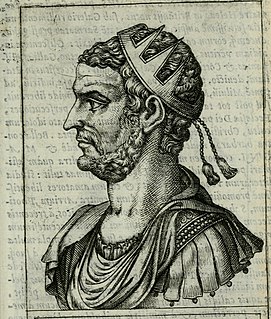
Martinian, who died in 325, was Roman Emperor from July to September 18, 324. He had been appointed co-emperor by Licinius.















